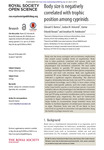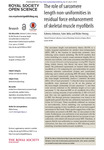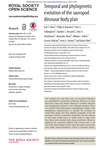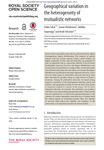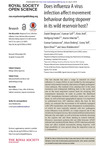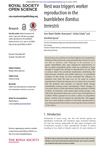Học liệu mở OER: Recent submissions
Now showing items 101-120 of 933
-
A synthetic, catalytic and theoretical investigation of an unsymmetrical SCN pincer palladacycle
(2016)The SCN ligand 2-{3-[(methylsulfanyl)methyl]phenyl}pyridine, 1, has been synthesized starting from an initial Suzuki–Miyaura (SM) coupling between 3-((hydroxymethyl)phenyl)boronic acid and 2-bromopyridine. The C–H activation ... -
Body size is negatively correlatedwith trophic position among cyprinids
(2016)Body size has many ecological and evolutionary implications that extend across multiple levels of organization. Body size is often positively correlated with species traits such as metabolism, prey size and trophic position ... -
Segregated water observed in a putative fish embryo cryopreservative
(2016)Development of new cryopreservation strategies has major potential in medicine and agriculture and is critical to the conservation of endangered species that currently cannot be preserved. A critical property of any potential ... -
The role of sarcomere length non-uniformities in residual force enhancement of skeletal musclemyofibrils
(2016)The sarcomere length non-uniformity theory (SLNT) is a widely accepted explanation for residual force enhancement (RFE). RFE is the increase in steady-state isometric force following active muscle stretching. The SLNT ... -
MiFish a set of universal PCR primers for metabarcoding environmental DNA from fishes
(2015)We developed a set of universal PCR primers (MiFish-U/E) for metabarcoding environmental DNA (eDNA) from fishes. Primers were designed using aligned whole mitochondrial genome (mitogenome) sequences from 880 species, ... -
Adaptive collective foraging in groups with conflicting nutritional needs
(2016)Collective foraging, based on positive feedback and quorum responses, is believed to improve the foraging efficiency of animals. Nutritional models suggest that social information transfer increases the ability of foragers ... -
Social familiarity affects Dianamonkey alarm call responses in habitat-specific ways
(2016)Male Diana monkeys produce loud and acoustically distinct alarm calls to leopards and eagles that propagate over long distances, much beyond the immediate group. Calling is often contagious, with neighbouring males responding ... -
Short and long term consequences of developmental saline stress
(2016)Secondary salinization has been identified as a major stressor to amphibians. Exposure to elevated salinity necessitates physiological adjustments and biochemical changes that may be energetically demanding. As such, ... -
Comparative phylogenetic analyses uncover the ancient roots of Indo-European folktales
(2016)Ancient population expansions and dispersals often leave enduring signatures in the cultural traditions of their descendants, as well as in their genes and languages. The international folktale record has long been regarded ... -
Temporal and phylogenetic evolution of the sauropod dinosaur body plan
(2016)The colossal size and body plan of sauropod dinosaurs are unparalleled in terrestrial vertebrates. However, to date, there have been only limited attempts to examine temporal and phylogenetic patterns in the sauropod ... -
Geographical variation in the heterogeneity of mutualistic networks
(2016)Plant–animal mutualistic networks are characterized by highly heterogeneous degree distributions. The majority of species interact with few partner species, while a small number are highly connected to form network hubs ... -
The unexpected survival of an ancient lineage of anseriformbirds into the Neogene of Australia
(2016)Presbyornithids were the dominant birds in Palaeogene lacustrine assemblages, especially in the Northern Hemisphere, but are thought to have disappeared worldwide by the mid-Eocene. Now classified within Anseriformes ... -
Does influenza A virus infection affect movement behaviour during stopover in its wild reservoir host?
(2016)The last decade has seen a surge in research on avian influenza A viruses (IAVs), in part fuelled by the emergence, spread and potential zoonotic importance of highly pathogenic virus subtypes. The mallard (Anas platyrhynchos) ... -
Food limitation of sea lion pups and the decline of forage off central and southern California
(2016)California sea lions increased from approximately 50 000 to 340 000 animals in the last 40 years, and their pups are starving and stranding on beaches in southern California, raising questions about the adequacy of their ... -
DNA barcoding to identify leaf preference of leafcutting bees
(2016)Leafcutting bees (Megachile: Megachilidae) cut leaves from various trees, shrubs, wildflowers and grasses to partition and encase brood cells in hollow plant stems, decaying logs or in the ground. The identification of ... -
Combining genetic and distributional approaches to sourcing introduced species
(2016)Three separate breeding populations of the Nile monitor (Varanus niloticus) have been identified in Florida, USA, located in Cape Coral, West Palm Beach and Homestead Air Reserve Base. This large, predatory lizard could ... -
Functional cervicothoracic boundary modified by anatomical shifts in the neck of giraffes
(2016)Here we examined the kinematic function of the morpho-logically unique first thoracic vertebra in giraffes. The first thoracic vertebra of the giraffe displayed similar shape to the seventh cervical vertebra in general ... -
Spatial variation in risk and consequence of Batrachochytrium salamandrivorans introduction in the USA
(2016)A newly identified fungal pathogen, Batrachochytrium salamandrivorans(Bsal), is responsible for mass mortality events and severe population declines in European salamanders. The eastern USA has the highest diversity of ... -
Heat dissipation during hovering and forward flight in hummingbirds
(2015)Flying animals generate large amounts of heat, which must be dissipated to avoid overheating. In birds, heat dissipation is complicated by feathers, which cover most body surfaces and retard heat loss. To understand how ... -
Nest wax triggers worker reproduction in the bumblebee Bombus terrestris
(2016)Social insects are well known for their high level of cooperation. Workers of the primitively eusocial bumblebeeBombus terrestris are able to produce male offspring in the presence of a queen. Nonetheless, they only compete ...


